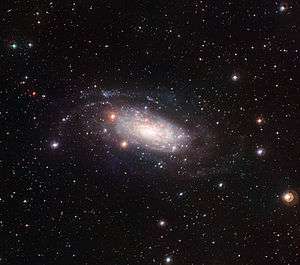NGC 3621
| NGC 3621 | |
|---|---|
 NGC 3621 taken by the Wide Field Imager (WFI) at ESO’s La Silla Observatory | |
| Observation data (J2000 epoch) | |
| Constellation | Hydra |
| Right ascension | 11h 18m 16.52s[1] |
| Declination | –32° 48′ 50.7″[1] |
| Redshift | 0.002435 ± 0.000007[2] |
| Helio radial velocity | +727[3] km/s |
| Distance | 21.7 million light years (6.64 Mpc)[4] |
| Apparent magnitude (V) | 10.0 |
| Characteristics | |
| Type | SA(s)d[1] |
| Mass | 2 × 1010[1] M☉ |
NGC 3621 is a field spiral galaxy about 22 Mly (6.7 Mpc) away[4][5] in the equatorial constellation of Hydra. It is comparatively bright and can be well seen in moderate-sized telescopes. The galaxy is around 93,000 ly (29,000 pc) across and is inclined at an angle of 25° from being viewed edge on. It shines with a luminosity equal to 13 billion times that of the Sun.[6] The morphological classification is SA(s)d,[1] which indicates this is an ordinary spiral with loosely wound arms.[7] There is no evidence for a bulge.[8] Although it appears to be isolated,[7] NGC 3621 belongs to the Leo spur.[6]
This galaxy has an active nucleus that matches a Seyfert 2 optical spectrum, suggesting that a low mass supermassive black hole is present at the core. Based upon the motion of stars in the nucleus, this object may have a mass of up to three million times the mass of the Sun.[8]
References
- 1 2 3 4 5 Bresolin, Fabio; et al. (May 2012), "Gas Metallicities in the Extended Disks of NGC 1512 and NGC 3621. Chemical Signatures of Metal Mixing or Enriched Gas Accretion?", The Astronomical Journal, 750 (2): 122, arXiv:1203.0956, Bibcode:2012ApJ...750..122B, doi:10.1088/0004-637X/750/2/122.
- ↑ Koribalski, B. S.; et al. (July 2004), "The 1000 Brightest HIPASS Galaxies: H I Properties", The Astronomical Journal, 128 (1): 16–46, arXiv:astro-ph/0404436, Bibcode:2004AJ....128...16K, doi:10.1086/421744.
- ↑ Tully, R. Brent; et al. (January 1995), "Recalibration of the H–0.5 magnitudes of spiral galaxies", Astrophysical Journal Supplement Series, 96 (1): 123–157, arXiv:astro-ph/9405047, Bibcode:1995ApJS...96..123T, doi:10.1086/192115.
- 1 2 Tully, R. Brent; et al. (March 2008), "Our Peculiar Motion Away from the Local Void", The Astrophysical Journal, 676 (1): 184–205, arXiv:0705.4139, Bibcode:2008ApJ...676..184T, doi:10.1086/527428.
- ↑ Materne, J. (April 1979). "The structure of nearby groups of galaxies - Quantitative membership probabilities". Astronomy and Astrophysics. 74 (2): 235–243. Bibcode:1979A&A....74..235M.
- 1 2 O'Meara, Stephen James (2013), Deep-Sky Companions: Southern Gems, Cambridge University Press, p. 203, ISBN 1107015014.
- 1 2 Buta, Ronald J.; et al. (2007), Atlas of Galaxies, Cambridge University Press, pp. 13–17, ISBN 0521820480.
- 1 2 Barth, Aaron J.; et al. (January 2009), "Dynamical Constraints on the Masses of the Nuclear Star Cluster and Black Hole in the Late-Type Spiral Galaxy NGC 3621", The Astronomical Journal, 690 (1): 1031–1044, arXiv:0809.1066, Bibcode:2009ApJ...690.1031B, doi:10.1088/0004-637X/690/1/1031.
External links
- A Picture-perfect Pure-disc Galaxy — ESO Photo release.
| Wikimedia Commons has media related to NGC 3621. |